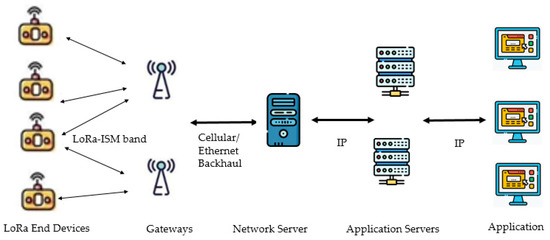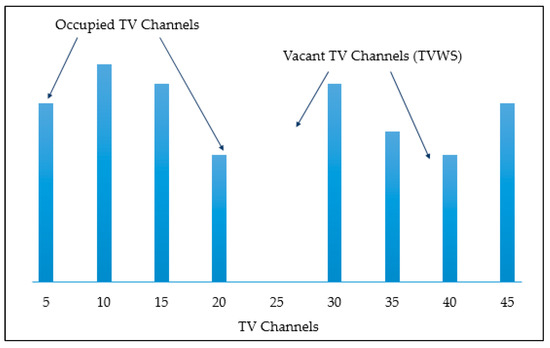Low power wide area network (LPWAN) is a wireless communication technology that offers large coverage, low data rates, and low power consumption, making it a suitable choice for the growing Internet of Things and machine-to-machine communication applications. Long range (LoRa), an LPWAN technology, has been used in the industrial, scientific and medical (ISM) band for various low-power wireless applications. TV white spaces (TVWS) are capable of transmitting signals over longer distances and do not require perfect line-of-sight transmission. They offer good coverage and stronger signals even in rural areas. TVWS frequencies can offer an alternative spectrum for LoRa-based LPWAN applications with reduced coexistence and interference issues and a further increase in the communication range for outdoor applications.
1. Introduction
Most wireless sensor networks (WSNs) and Internet of Things (IoT) applications need to work with low power and provide long-range and wide coverage. Wireless technologies known as low power wide area networks (LPWANs) include wide coverage regions, less bandwidth, small data packet sizes, and extended battery life. For IoT applications that require close to real-time communication, little power consumption, and extensive connection, LPWAN technologies are better suited.
Long range (LoRa) is an LPWAN technology by LoRa Alliance that basically operates in the sub-GHz, industrial, scientific and medical (ISM) band frequencies
[1]. As the name implies, LoRa’s long-range transmission capability with less power consumption makes it a key player in IoT networks
[2]. LoRaWAN aims to aid terminals running on a single battery for a longer time with enhanced coverage. LoRaWAN networks generally use a star topology where gateways pass messages to and from the end devices and a centralized web server. End devices use single-hop LoRaWAN communications that can be received on one or more gateways and are connected to the network server via IP links. Typically, communication is two-way. For general bandwidth availability, uplink communication between the terminal and the web server is recommended. As it uses the license-free ISM band, parameters such as channel frequency, transmit power, and duty cycle vary with the geographical region, which determines the hardware and protocol design. Smart applications in Industrial IoT (IIoT), cities, homes, buildings, utilities, metering, supply chain and logistics, and agriculture, all benefit from LoRa’s adaptability for indoor and outdoor use
[3].
Current lifestyles and the lack of licensing requirements have promoted the development and growth of wireless applications such as consumer and commercial WiFi and wireless local area network (WLAN) applications, commercial radio frequency identification (RFID) applications, and other ISM band monitoring applications. As a result, there is a ubiquitous increase in the number of wireless devices occupying the ISM band leading to coexistence and interference issues
[4]. Coverage is essential in almost all LPWAN use cases
[5]. Therein lies the need to explore available alternative spectrums for such growing wireless and LoRa applications.
TV white spaces (TVWS) are the currently vacant portions of the TV spectrum, especially in the 300 MHz–3 GHz, very high frequency (VHF), and ultra high frequency (UHF) bands. This spectrum can be exploited by primary (licensed) or secondary users, who can share it with other users, including digital TV transmitters while using unlicensed equipment. The amount of terrestrial whitespace availability depends on several aspects, such as TV coverage, TV channel usage, geographical features, interference, and so on. Identification of TVWS and allocation is based on database registration or the spectrum sensing-approach to ensure coexistence and interference avoidance with other users
[6].
2. LoRa, TVWS, and Related Work
LoRa, a physical layer technology promoted by LoRa Alliance, employs chirp spread spectrum (CSS) modulation, improving link budget and interference resilience. It uses the 433, 868, and 915 MHz ISM bands and the medium access control (MAC) layer protocol (LoRaWAN). The data sent by a LoRa node in a LoRaWAN star topology network may be received by multiple nearby gateways that relay the data via an IP interface to a network server, as illustrated in Figure 1.
Figure 1. Basic LoRa network architecture.
CSS modulation spreads the information signal spectrum by a continuously varying frequency chirp carrier signal. The extent of spreading that happens to the original data signal is termed the spreading factor (
SF)
[1]. One LoRa symbol can encode
SF bits of information, and one symbol’s duration depends on
SF and the bandwidth as given in,
where
Ts is the symbol duration,
SF is the spreading factor, and
BW is the bandwidth. LoRa uses the forward error correction (FEC) method, and the code rate (CR) is {4/5, 4/6, 4/7, or 4/8}. Typically, bandwidth supported is {125, 250, 500} kHz and
SF = {7, 8, 9, 10, 11, 12}. Transmit power values usually chosen are {2, 5, 8, 11, 14} dBm
[7]. The channel frequency selected depends on the region of operation. Bandwidth, spreading factor, code rate, channel frequency, and transmit power are important parameters that can be chosen for LoRa modulation and influence the modulation bit rate and resistance to interference
[8][9]. The communication range for higher SF values increases, but time on air (ToA) also increases, reducing the data rate. The symbol duration affects the time on air; as time on air increases, the energy required to transmit the data packet also increases. Thus, the
SF value, the channel frequency, and transmit power decide the range and energy requirement. LoRa nodes communicate using pure ALOHA, and the LoRa network uses adaptive data rate (ADR) at the gateway, ensuring good network throughput. Different spreading factors result in orthogonal signals and data rate changes. The gateway can simultaneously receive several data rates on the same channel
[10].
TVWS refers to broadcast frequency bands in certain parts of the spectrum that are unused due to the digitization of TV services and bands free at different times, as presented in
Figure 2. The lower frequency ranges of TVWS (50–698 MHz) penetrate well through obstacles making them less prone to fading and multipath, thus enabling indoor and consumer applications. The bandwidth offered by TVWS is large, thus supporting various high-bit-rate applications too. In contrast to ISM bands, enough TVWS may be generally accessible, especially in rural regions, since there are fewer TV stations than in metropolitan areas
[11]. TVWS has good propagation characteristics, excellent indoor penetration, and higher spectral efficiency, making it a good prospect for a wide range of significant indoor and outdoor wireless applications. TVWS is appropriate for applications that need a wide transmission range.
Figure 2. TV white spaces illustration.
The Federal Communications Commission (FCC) permitted the unlicensed use of TVWS in 2008
[12]. Most countries have rules for the licensed or unlicensed use of TVWS. The United States, United Kingdom, Canada, Singapore, Mozambique, Japan, and Hong Kong have regulations for the use of TVWS for fixed and mobile wireless communications. The United States has enabled licensed access to TVWS for wireless broadband and mobile data services. The Indian government has issued experimental licenses in the 470–590 MHz band to perform trials at several places using TVWS, unlocking prospects for using the TVWS spectrum in India in either an unlicensed or lightly licensed manner. Literature studies show several TVWS use cases dedicated to rural wireless broadband access, home networks, WLAN applications, and smart metering. Several pilot projects, mostly in rural areas using TVWS, are demonstrated in Africa, Europe, Asia, North America, and Germany. The analog-to-digital TV transition has freed up the TVWS for future 5G networks in Portugal
[11].
Different software platforms and hardware operating over various frequency ranges for LPWAN is available. LoRa transceivers operating in the 137 MHz to 1020 MHz frequency band are also currently available. Semtech, a leading member of the LoRa Alliance, has the SX126* and SX127* series of LoRa modules that support different frequency bands
[13]. Most of the research and applications are focused on using LoRa in the ISM band, hence this attempt to study the use of TVWS frequencies, primarily the licensed bands for LoRa, as shown in
Figure 3.
Figure 3. TVWS-based LoRa model.








